What Goa is to Mumbai, Al Ain is to Dubai — a well-developed holiday destination offering footsore shopaholics a feast of rest and recreation opportunities

History is likely to prove that the rulers of the tiny port city state of Dubai (pop. 3.49 million) were considerably wiser than the sheikhs and princes of other states, nations and kingdoms of the Middle East. For over four decades, Dubai has progressively reduced its dependence on crude oil revenue and has metamorphosed into a thriving entrepot and shopping mecca attracting shopaholics from around the world, and South Asia in particular. Last year an estimated 900,000 visitors from India visited or transited through Dubai and the number is growing at nearly 15 percent per year.
Contrary to popular opinion, there’s more to Dubai than mere shopping and gourmandising. For a start, it’s important for visitors to appreciate this port city is a self-administered constituent of the United Arab Emirates (UAE), a federation of seven independent sheikhdoms which represent the liberal accommodating spirit of Islam, widely perceived as uncompromisingly militant. Unlike most Middle Eastern countries, the emirates with their high tolerance of tourists from West and East have a thriving tourism industry. With an aggregate population of 9.89 million, the UAE comprises Abu Dhabi (Abu Zaby), Ajman, Dubai, Al Fujayrah, Raas al Khaymah, Ash Shariqah aka Sharjah, and Umm al Qaywayn and sprawls over an area of 83,600 sq km with a 1,318 km coastline.
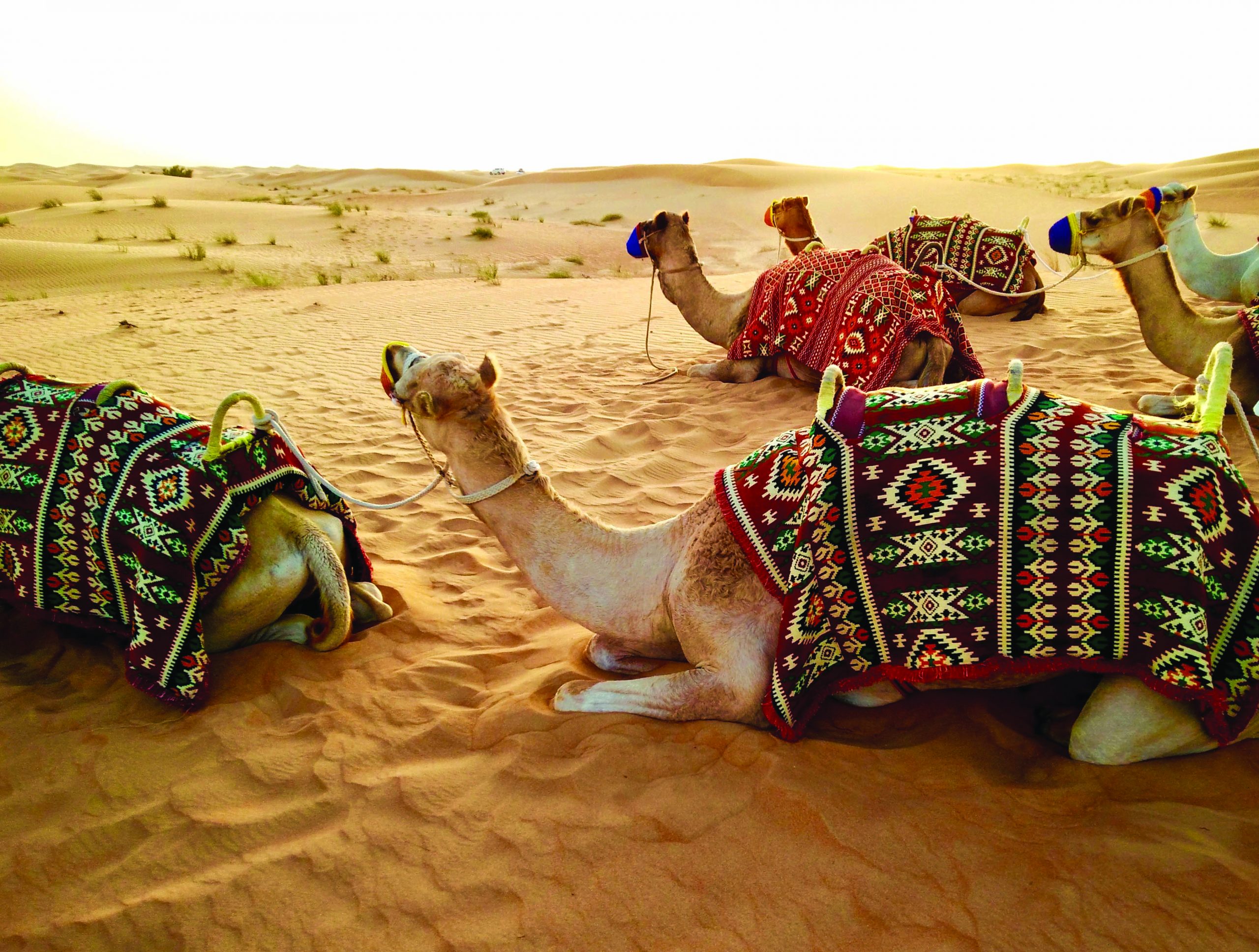
Desert Safari
Although contemporary Dubai is also promoted as a holiday destination in its own right with white sandy beaches stretching to the horizon, exclusive hotels, Ali Baba’s cave style shopping malls and activities such as snow-skiing, desert safari, camel and ostrich racing, dune and wadi bashing, the UAE’s prime holiday destination is Al Ain, the tourist town of the emirate of Abu Dhabi, a 90-minute drive (144 km) from Dubai. What Goa is to Mumbai, Al Ain is to Dubai − a well-developed holiday destination offering footsore shopaholics a feast of rest and recreation opportunities.
Built around an oasis close to the Dubai-Oman border, Al Ain (pop. 766,000) is a green low-rise city sited in the shade of the Jebel Hafeet mountains. Surrounded by awesome red sand dunes and the craggy Jebel Hafeet range of mountains, Al Ain is linked by excellent motorable roads to Abu Dhabi, Dubai and Sharjah. The drive from Dubai to Al Ain down an eight-lane autobahn-style motorway is just over an hour.
Blessed with generous groundwater resources and self-renewing aquifers, Al Ain is one of the most fertile agricultural areas in the UAE, often described as the ‘garden city of the Gulf’. In Arabic Al Ain translates into ‘spring’ and the region with its ancient but efficient non-mechanised falaj irrigation system boasts sprawling date plantations.
Al Ain has a history which can be traced back over four millennia as evidenced by numerous archaeological excavation sites which date settlements to around 3000 BC. Its more recent history is centered around seven restored plantations or oases where 42 carefully preserved forts and settlements attract droves of ex-Dubai tourists in the winter months (November-February) in particular. It is also a university town. UAE University is sited here against a scenic mountainous backdrop.
Unsurprisingly, university academics are prepared to argue that Al Ain showcases Arab culture and traditions at their best. A tour of the city offers visitors contrasts of old and new, turrets and watchtowers of old forts jostling with modern steel and glass skyscrapers. Paradoxically and delightfully, the UAE’s sole camel trading market is also located in a suburb of the city.
Sited in the epicenter of a cool date plantation, the Al Ain Oasis is perhaps the most popular attraction of this resort town. Divided into numerous well-maintained date farms, the oasis is popular with tourists walking through its quiet shades in lush greenery. Gardeners cultivating huge palms, through the traditional falaj irrigation system attract the focussed attention of visitors.
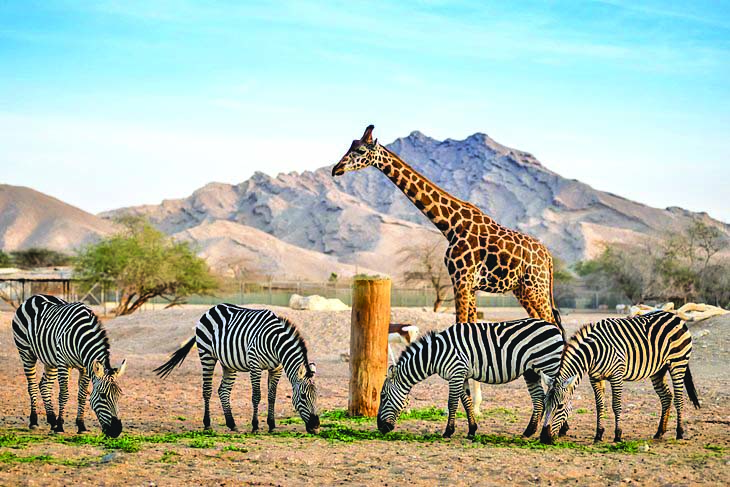
The Al Ain Zoo
The Al Ain Zoo and Aquarium is the largest in the Middle East. Spread over 400 hectares, the zoo hosts a wide variety of animals from Africa, India and Arabia and its huge aquarium houses exotic collections of marine species. Zoo inhabitants include elephants, tigers, bears and other animals peculiar to the desert. Spacious cat enclosures, gorilla and monkey compounds, a reptile house, and near-natural aviaries make viewing a pleasant experience, especially for children. The zoo is also a research centre, particularly for the region’s endangered native animal species.
Sited adjacent to the Al Hosn Fort, the Al Ain Museum houses extensive archaeological and ethnographic collections, including beautiful gold pendants and an impressive coin collection apart from an array of gifts received by UAE’s president from visiting statesmen and royalty. The ethnographic section reflects the history of the people of the region, while the archaeological section displays discoveries dating back to the Bronze and Iron ages. The Al Ain Museum with its varied display offers an understanding of the hardy and durable people of this region who have only recently begun to experience the comforts of modern industry and technology.
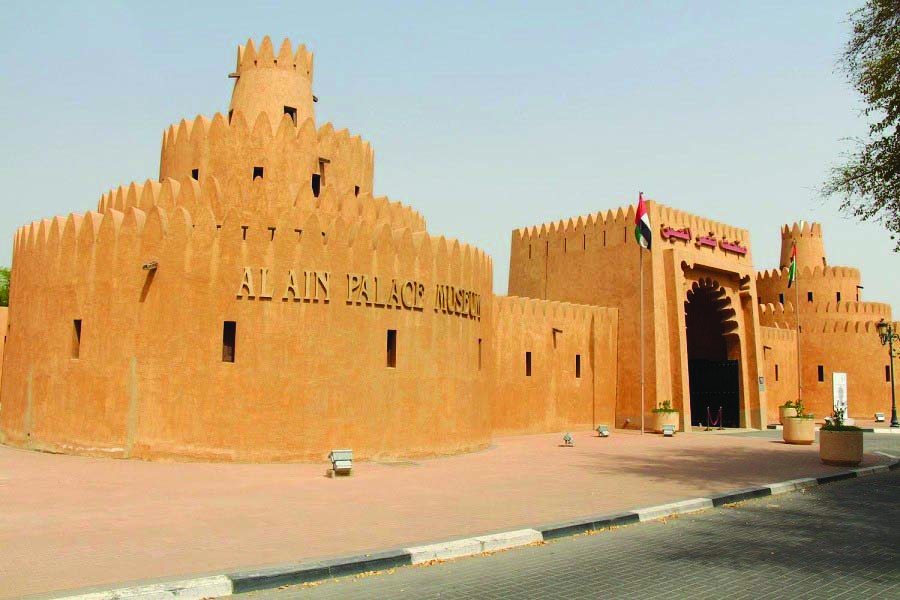
Al Ain Museum
The century-old Eastern Fort, located within the compound of Al Ain Museum is the ancestral home of the ruling emirs. The fortress with its high walls and four watchtowers has canons flanking its impressive main doorway. The fort is usually locked but is open to visitors during museum hours. Another interesting landmark of Al Ain is the Old Prison. It offered the incarcerated fine views of this desert town and the oasis.
Although Al Ain boasts over 42 forts, the best examples of Arab fort architecture are the Al Jahili Fort − a large, restored structure with distinctive corner turrets; Al Mujairib Castle comprising a main and smaller fort, a 50 ft tall watchtower, surrounded by a park and children’s playground; Hili Fort with its ornate entrance and sprawling courtyard, Al Rumeilah famous for its sandstone architecture and the Al Murabba and Mazyad forts.
The scenic Hili Archaeological Park and Fun City, the largest theme park in the UAE with over 40 assorted rides set amidst expansive landscaped gardens with picnic facilities and numerous food courts, is particularly recommended for visitors with children. Special shows are organised from time to time in the park’s manicured gardens surrounding several carefully preserved bronze and iron age sites, dating back circa 2,500-400 BC. These sites also feature the beautifully restored Grand Garden Tomb, a circular construction with three internal dividing walls housing the remains of over 200 ancient rulers of the emirate. Contiguous to Hili Fun City is the Al Ain Ice Rink, a magnificent Olympic-sized facility offering numerous children’s games in addition to ice skating.
Likewise, visitors are drawn to the Ain Al Faydah resort to the south of the city in a spectacular setting at the base of the Hafeet Mountain. Surrounded by jagged cliffs, the resort is dotted with picnic spots in beautifully maintained gardens, a lake with boating facilities, swimming, ten-pin bowling etc.
Al Ain’s unique selling proposition is that it is a conglomeration of several oases perpetually renewed by subterranean aquifers. Therefore it is paradoxically a lush green haven set amidst a blazing desert. Hence its main attractions are its lovingly tended parks, plantations and green spaces. The Central Public Garden is one of the largest parks in the city and hosts a spectacular musical dancing fountain which mesmerises visitors with its changing shapes and lighting effects. The contiguous children’s adventure playground offers wall climbing, grass skiing and other facilities.
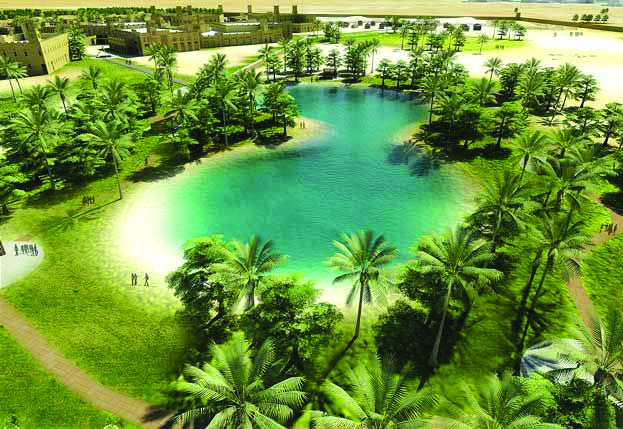
Al Ain Oasis
For the academically inclined, a visit to UAE University, established in 1976 is recommended. Designed and constructed in impressive Islamic architectural styles, the university has an enrollment of 12,000 students.
Also recommended is a drive through the Jebel Hafeet Mountain range − whose highest peak rises to 4,860 ft − on a 13-km-long smooth and wide highway. The summit offers magnificent vistas of the city and its environs. Also soak your feet in the Hot Springs on the way to the mountains through arid desert settings.
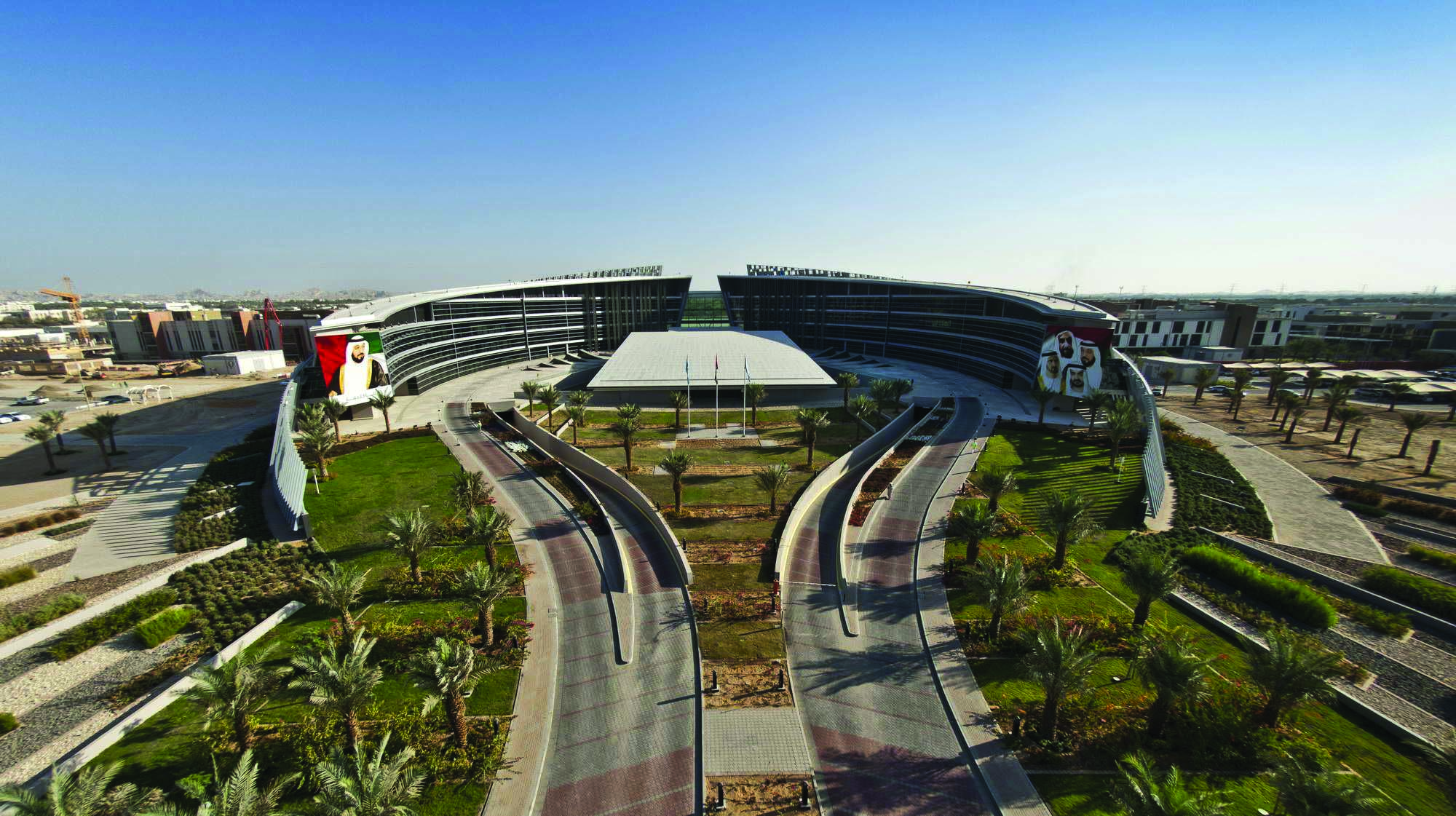
UAE University
Traditional souq. The souqs or markets in downtown Al Ain offer a glimpse into the daily life of the people of the region. Visitors to the central meat, fish and vegetable souq can feast on a fascinating array of cuisines served in a traditional Arab ambience redolent of oriental spices, colours and street sounds.
Leisure sports activities. Most visitors from the subcontinent dazzled by the malls and shopping arcades of Dubai and Sharjah don’t know it, but the UAE also offers exceptionally well-developed desert and water sports opportunities. For the sports-minded and adventurous, there are several options including camel rides through magnificent red sand dunes, overnight camping safaris, sand and grass golf.
Camel racing. The camel racing season is from October-March when races are held at the Camel Race Track located to the west of Al Ain, just off the road to Abu Dhabi. It’s worth experiencing these exciting races and the electric atmosphere, free of charge.
Sand golf. A full sized 18-hole sand course offers golfers a unique opportunity to tee off into undulating sand dunes. Hundreds of aficionados golf on the course during weekends.
Grass golf. Sited on the property of the Hilton Hotel this nine-hole, par three golf facility covering 40 acres has been put together with imported soil and grass. It is an ideal facility for practicing short games.
Dog racing. The UAE has a long tradition of breeding hunting dogs. In keeping with this tradition an exclusive stadium has been constructed to conduct fortnightly canine races during the cooler months. Entry is free and a lot of betting happens during the races.
Caving. The Jebel Hafit mountains have a labyrinthine caves network. Even for experienced caving enthusiasts it is advisable to employ the services of cave guides and be well-equipped with flashlights, water and protective clothing.
Accommodation. As a well-developed leisure destination, Al Ain boasts luxurious 5-star resort hotels − The Hilton, The Intercontinental and Rotana − all set in expansive and meticulously landscaped environments. Apart from luxury rooms and suites, they offer secretarial services, communication and conference facilities. Leisure facilities include swimming, tennis, spas, gymnasiums, golf, squash and ten-pin bowling. Contrary to popular expectation, Al Ain has a swinging night life in its crowded restaurants, bars, discotheques and night clubs.
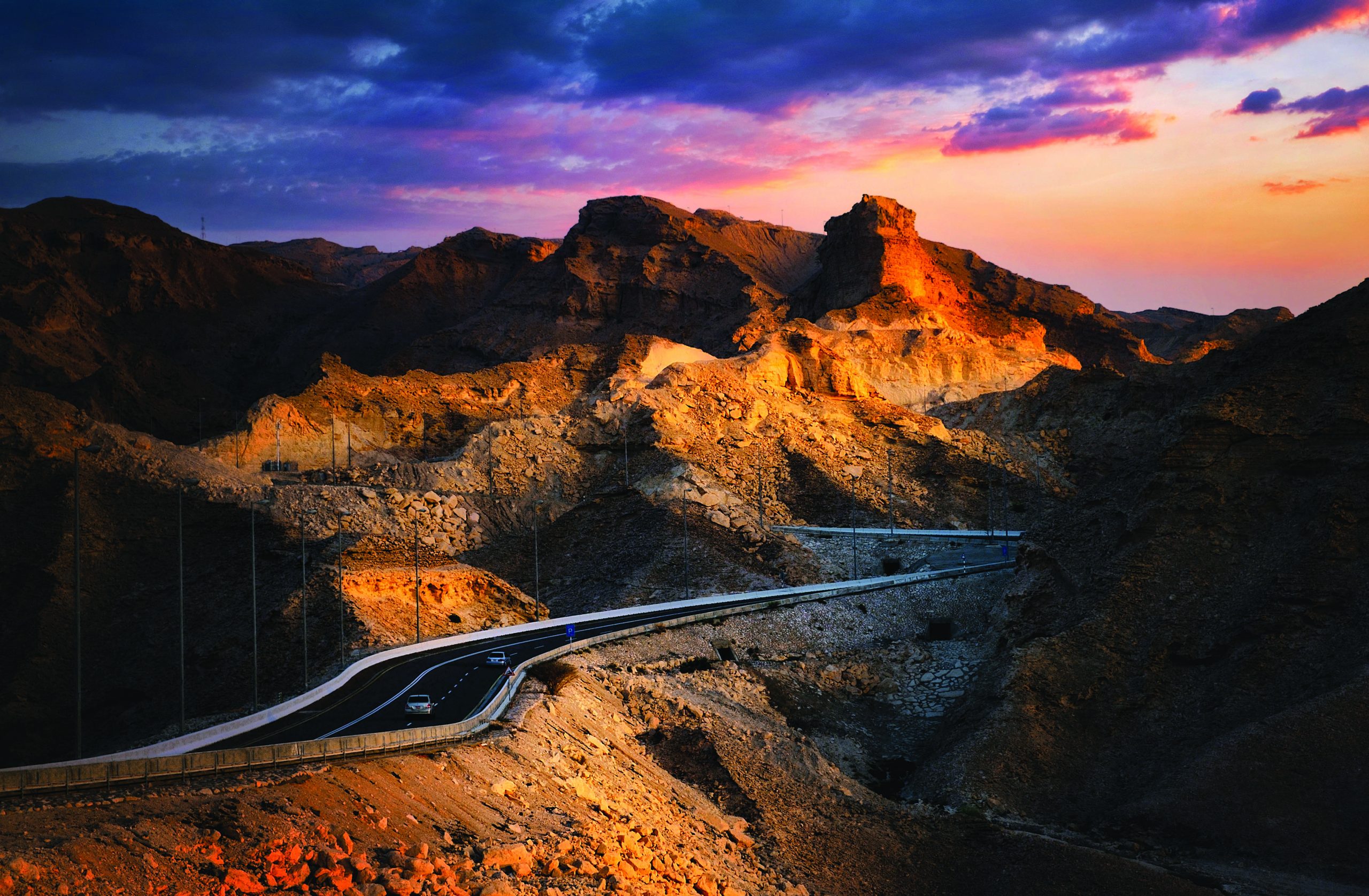
Jebel Hafeet mountain range
Top-end: Telal Resort Al Ain (Rs.15,000 per night), Al Ain Rotana (Rs.7,051), Green Mubazzarah Chalets (Rs.13,000). Mid-range: City Seasons Hotel Al Ain (Rs.5,043), Ayla Grad Hotel (Rs.5,856), Hili Rayhaan by Rotana (Rs.6,990). Budget: Mercure Grand Jebel Hafeet Al Ain Hotel (Rs.3,498), Danat Al Ain Resort (Rs.4,000), Al Massa Hotel Buremi (Rs.1,866) (NB: 1 UAE DH = Rs.20.73)

























